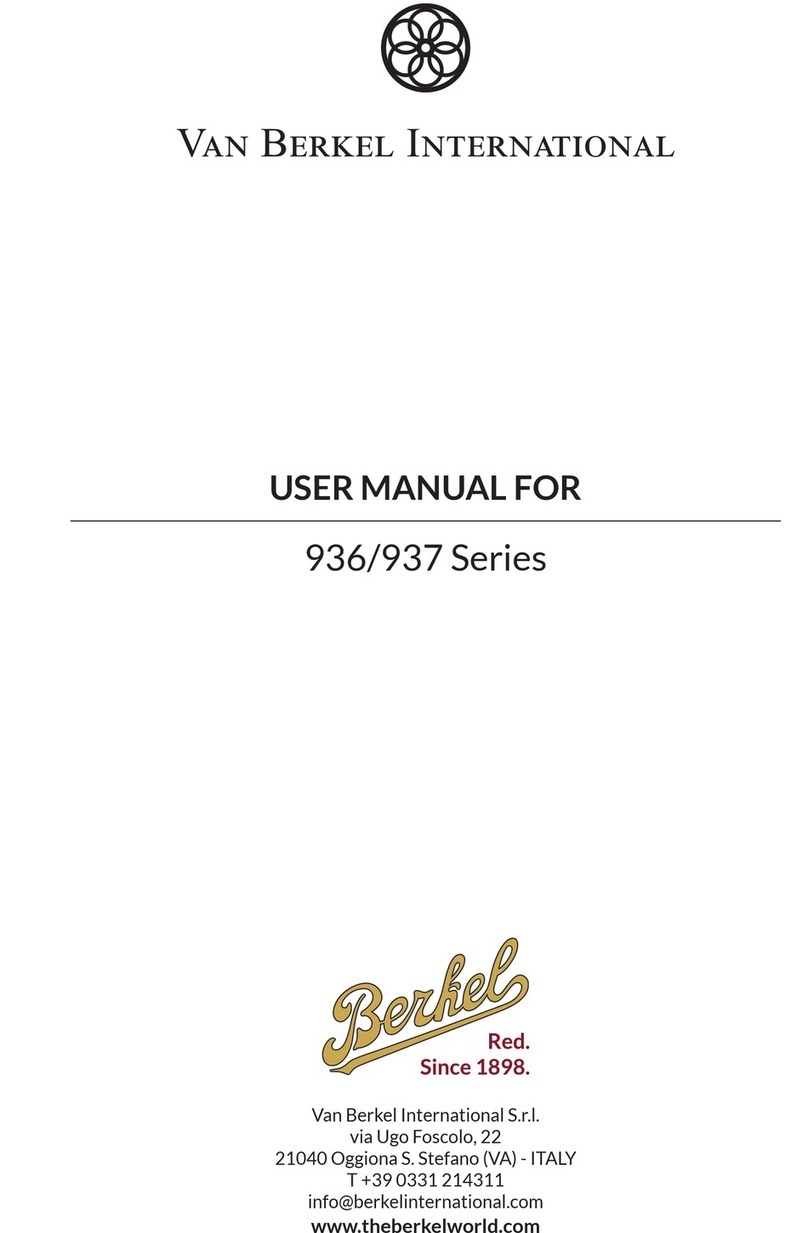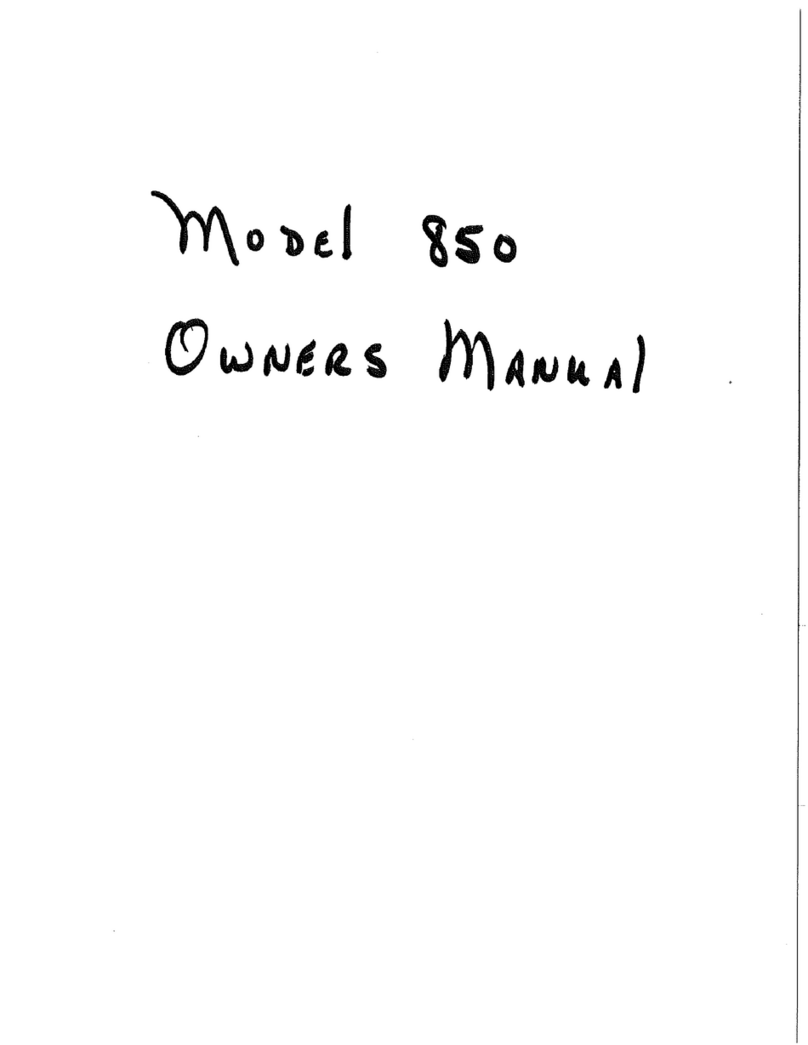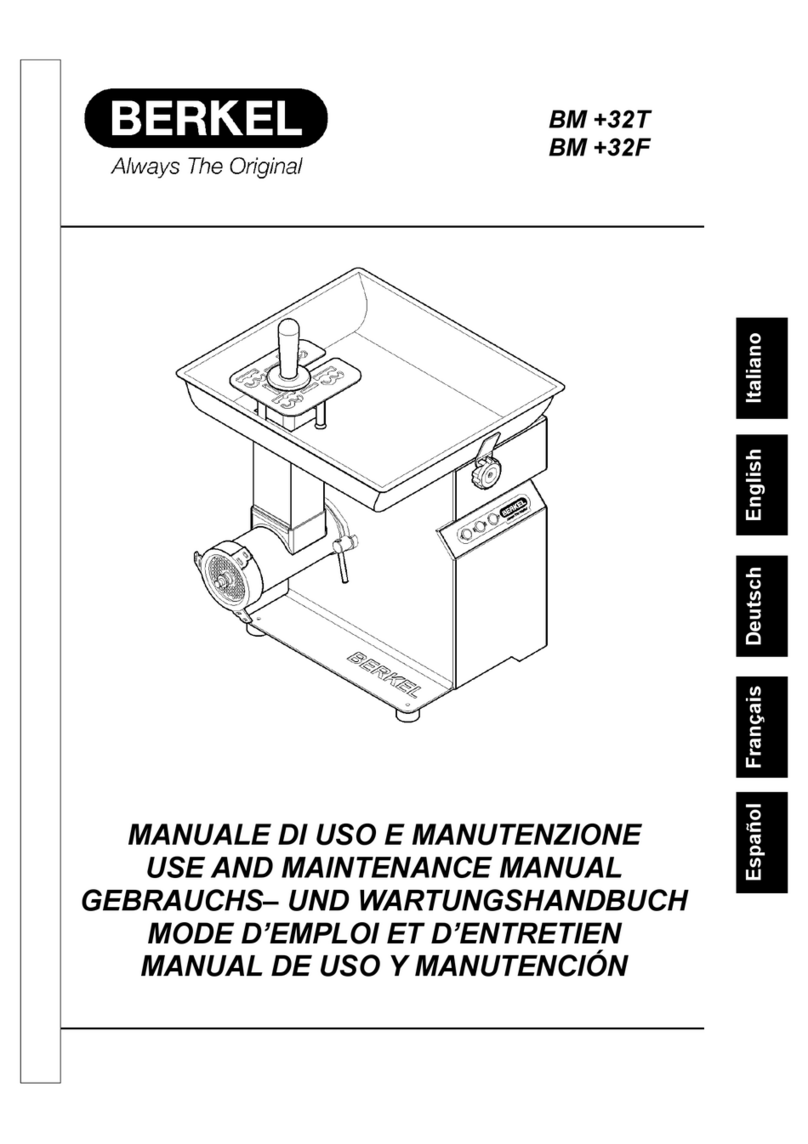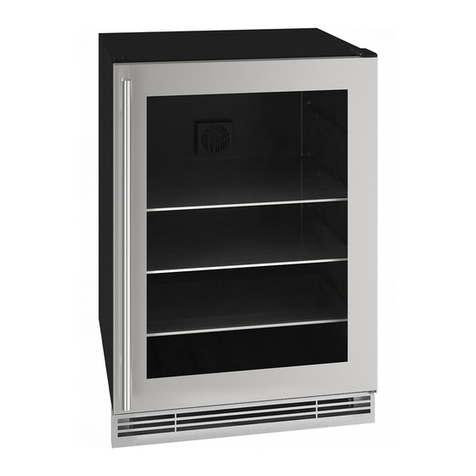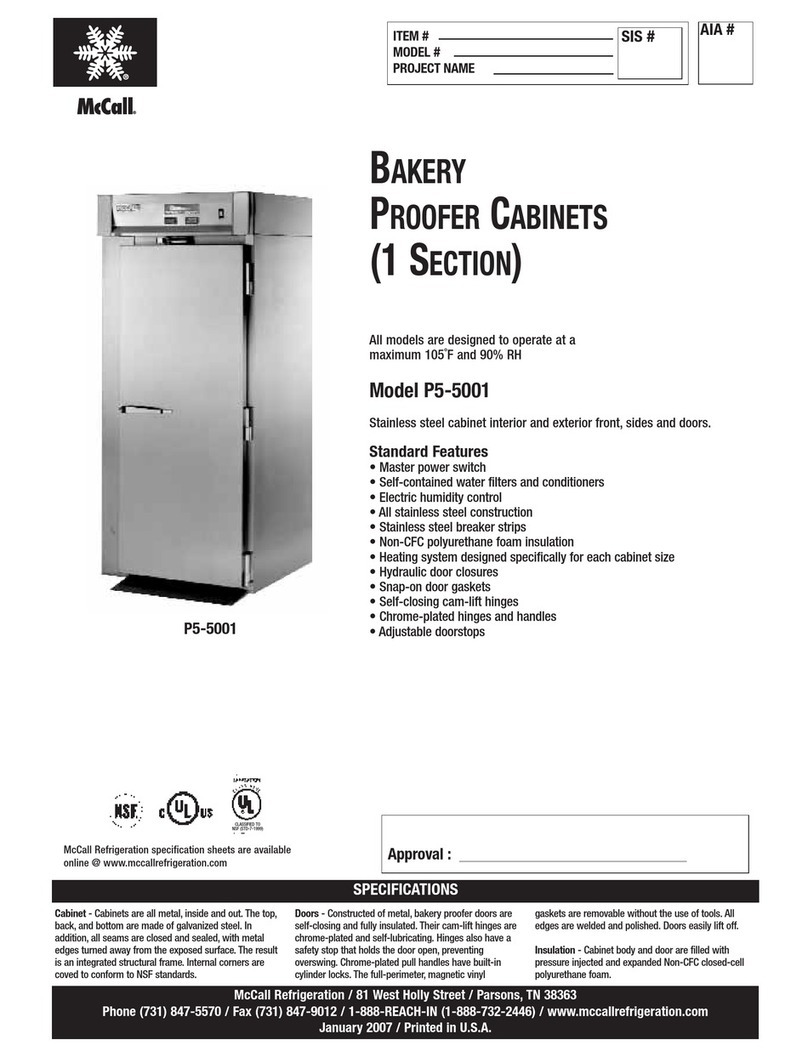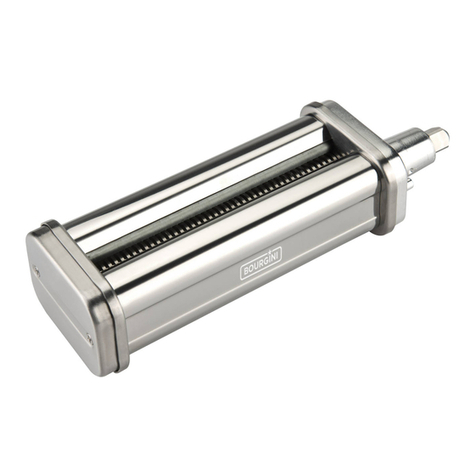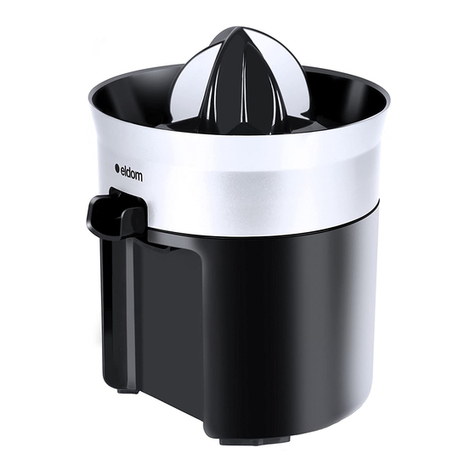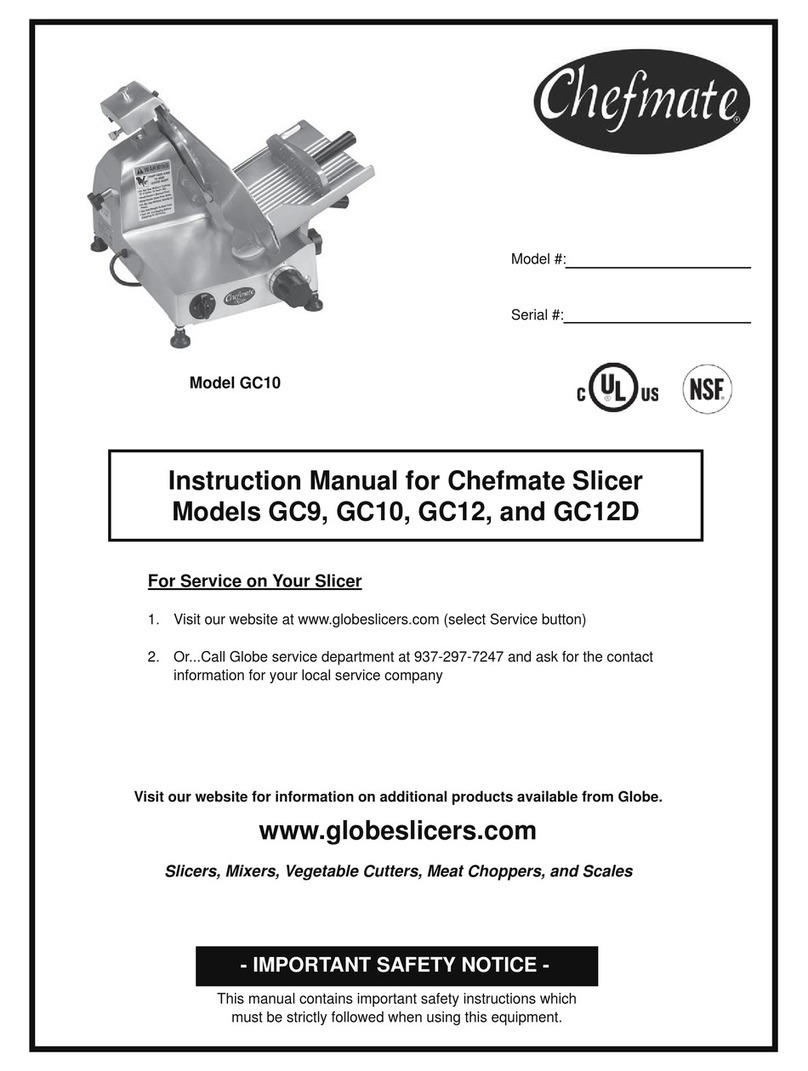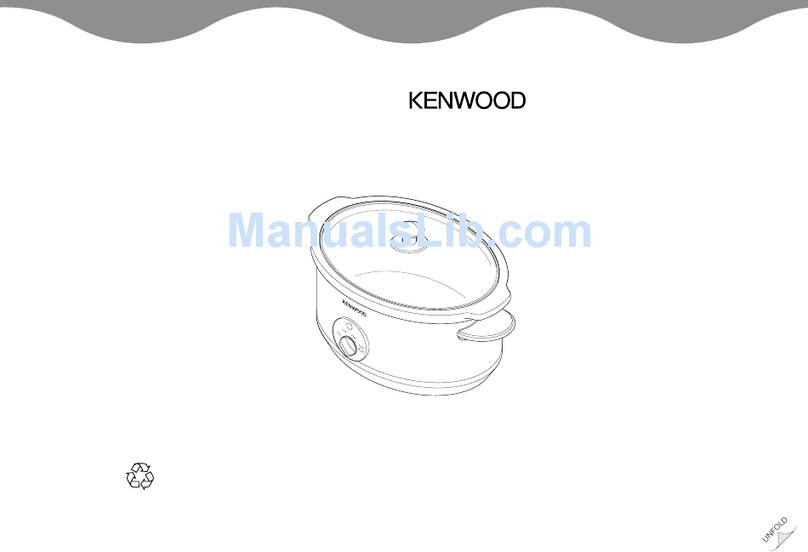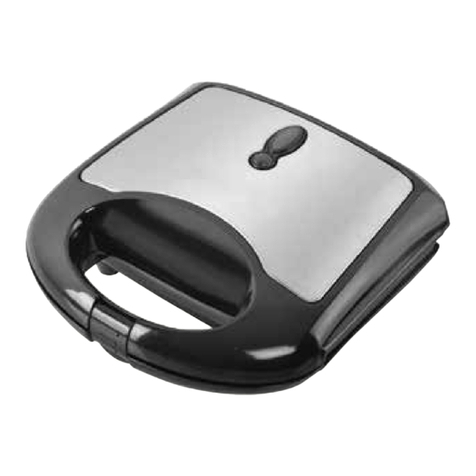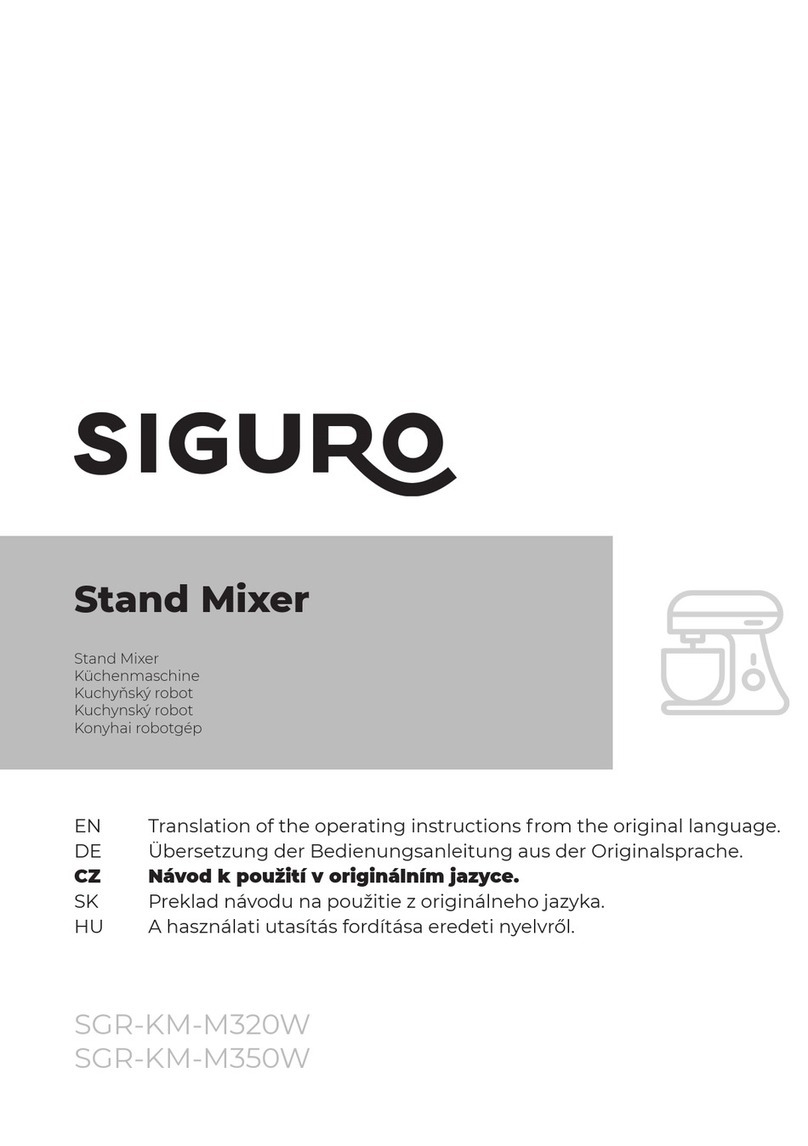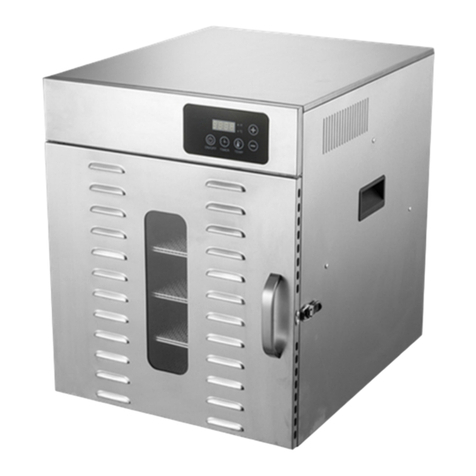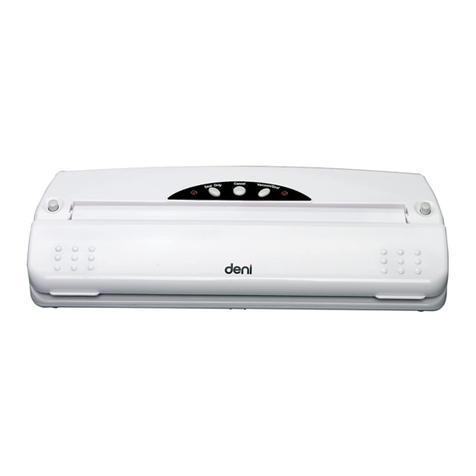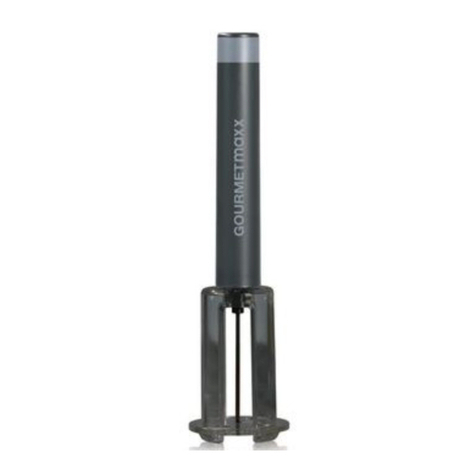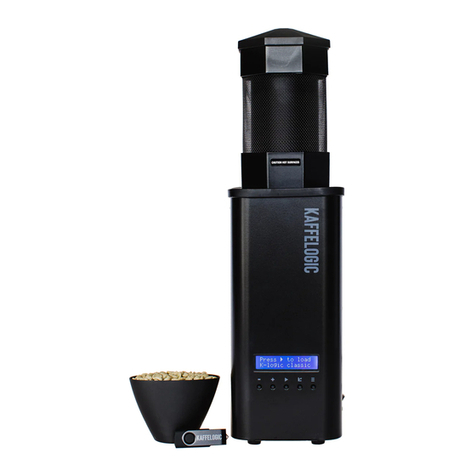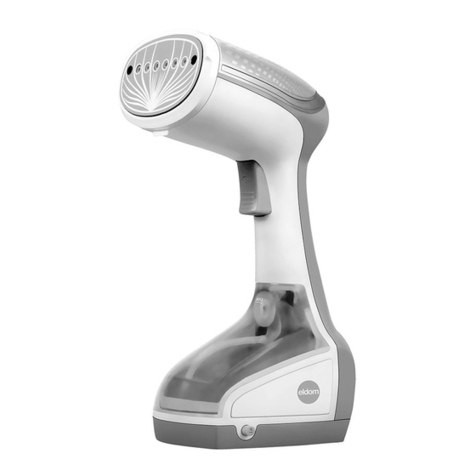Berkel Suprema Series User manual

USER MANUAL
MANUALE D’USO
GEBRAUCHSANLEITUNG
MANUEL D’INSTRUCTIONS
NÁVOD K POUŽITÍ
BETJENINGSVEJLEDNING
EN
DE
CS
IT
FR
DA
MANUAL DEL USUARIO
HANDLEIDING
BRUKSANVISNING
MANUAL DE INSTRUÇÕES
MANUAL DE INSTRUCTIUNI
BRUKSANVISNING
NO
RO
NL
PT
ES
SV
SUPREMA SERIES
PES315/PES350/PES370 (Salumeria)
PEM350/PEM370 (Macelleria)
PEG315/PEG350/PEG370 (Gravità)
PED315 (Delicatessen)
CODE: MAN-SUP-001

(A)
(D) (E-1)
(F-1)
(B) (C-1)
1
2
3
4
(C-2)
(C-3)
(G)
(L)
(E-2) (F-2)
(I)
(H-2)
(C-3)

3
Fig. 1
Abb. 1
Obr. 1
Afb. 1
Bild 1

4
USER MANUAL: Electric Slicers Suprema
MODELS:
PES315/PES350/PES370 (Suprema Salumeria); PEM350/PEM370 (SupremaMacelleria);
PEG315/PEG350/PEG370 (Suprema Gravità); PED315 (Suprema Delicatessen)
EN
Fig. 2
PES Serie
MAIN
COMPONENTS
1. Start button
2. Stop button
3. Slice thickness
regulating knob
4. Foot
5. Handle for plate pushing
6. Carriage
7. Plate locking knob
8. Meat table
9. Sliding overplate
10. Top clamp
11. Blade cover (blade cover)
12. Sharpener
14. Thickness gauge plate
15. Casing
16. Identication plate,
technical data and CE
marking
17. Lubricating point for guide
bars
18. Blade
19. Blade cover tension rod
20. Slice deector
21. Blade guard ring
22. Block
23. Power cord
26. Food press manouevering
lever
12
3
12
19
26
10
9
18
20
21 22 5
17
16
23
4
56
7
8
9
10
11
12
14
15
26

5
PEM - PED Series
MAIN
COMPONENTS
1. Start button
2. Stop button
3. Slice thickness
regulating knob
4. Foot
6. Carriage
7. Plate locking knob
8. Meat table
9. Sliding overplate
10. Top clamp
11. Blade cover (blade cover)
12. Sharpener
13. Product holder handle
14. Thickness gauge plate
15. Casing
16. Identication plate,
technical data and CE
marking
17. Lubricating point for guide
bars
18. Blade
19. Blade cover tension rod
20. Slice deector
21. Blade guard ring
22. Block
23. Power cord
24. Meat table safety guard
12
3
12
13
19
17
24
16
23
4
67
8
9
10
11
12
14
24
15
Fig. 2

6
Fig. 2
PEG Serie
MAIN
COMPONENTS
1. Start button
2. Stop button
3. Slice thickness
regulating knob
4. Foot
5. Handle for plate pushing
6. Carriage
7. Plate locking knob
8. Meat table
10. Top clamp
11. Blade cover (blade cover)
12. Sharpener
13. Product holder handle
14. Thickness gauge plate
15. Casing
16. Identication plate,
technical data and CE
marking
17. Lubricating point for guide
bars
18. Blade
19. Blade cover tension rod
20. Slice deector
21. Blade guard ring
23. Power cord
24. Meat table safety guard
1
2
3
12 13
13
14
18
19
17
24
16
23
4
6
7
7
5
10
11
14 8
15
21

7
DESCRIPTION
Circular blade professional
slicer machine suitable for
cutting only the food products
of the types and within the di-
mensional limits indicated in
this manual. The main parts of
the machine are shown in the
general component diagram
reported in picture 2. Electrical
diagrams are reported in pic-
ture 1.
DECLARATION
OF CONFORMITY
The machines described in this
manual comply with Direc-
tives 2006/42/CE, 2006/95/
CE, 2004/108/CE, 2003/108/
CE, 2011/65/CE, Regulation
(EC) 1935/2004 and related
harmonized standards as EN
1974:1998 +A1, EN60204-1,
EN60335-1, EN60335-2-64.
SAFETY
Pay attention to the following
basic safety precautions:
- read all the instructions be-
fore using the machine;
- this product is not intended
to be used by children;
- operate the machine only if
properly trained and in perfect
psycho-physical conditions;
- do not use the machine in any
way other than what indicated
in this manual;
- use the machines only in full
structural, mechanical and sys-
tem efciency;
- install the machine in con-
formity to the instructions
indicated in the “Installation”
section;
- install the machine in a loca-
tion out of the reach of person-
nel unauthorized to operate it
and especially out of the reach
of minors;
- stay highly concentrated
when using the machine and
avoid any distraction during
use;
- do not allow the machine to
be used by others who have
not read and fully understood
the content of this manual;
- do not wear baggy clothing or
clothing with open sleeves;
- do not allow anyone else,
other than the operator, to ap-
proach during product cutting
operations;
- do not remove, cover or
modify the tags located on the
machine body and, in case of
damage of these, replace them
promptly;
- do not remove the transpar-
ent guards and do not modify
or bypass any mechanical and
electrical protective devices;
- slice only the permitted prod-
ucts, do not attempt cuts on
prohibited type products;
- always keep clean and dry the
sliced product resting surface,
the work area all around the
machine and the operator oor
area;
- do not use the machine as
a resting surface and do not
place any objects on it other
than food used for cutting op-
erations;
- do not use the slicer when,
due to normal wear, the dis-
tance between the edge of
the blade and the blade guard
ring exceeds 6 mm. In this case,
contact the manufacturer or to
one of the Authorized Service
Centers to change the blade;
- do not use the machine with
temporary or non-insulated
cables, power strips or exten-
sion cords;
- periodically check the condi-
tion of the power supply cord
on the machine body. When
necessary, have qualied per-
sonnel replacing it;
- immediately stop the ma-
chine in the event of a defect,
abnormal operation, suspicion
of breakdown, incorrect move-
ment, unusual noises;
- before cleaning or carrying
out maintenance, disconnect
the machine from the electri-
cal supply;
- use protective gloves for
cleaning and maintenance op-
erations;
- place and remove the goods
to be sliced on the sliding plate
only with the carriage com-
pletely pulled back and with
the thickness adjustment knob
placed in the safety position
(on the 0 position);
- for movement of the meat
table during cutting operations
use only the handle located on
the arm or the product presser
grip;
- never put your hands on the
food product while slicing. Al-
ways keep your hands behind
the protection devices and far
from the blade;
- use of cutting accessories
which were not provided by
the manufacturer with the ma-
chine is prohibited.
The manufacturer declines any
responsibility coming from in-
appropriate use, modications
and/or repairs carried out by
the user or unauthorized per-
sonnel, use of replacement
parts that are not original or
not specic for the machine
model.
The machine shall not be used
in open areas and/or areas
which are exposed to atmos-
pheric agents and in environ-
ments with vapors, fumes or
corrosive and/or abrasive pow-

8
ders, with risk of re or explo-
sion and in any case where the
use of antiexplosive compo-
nents is required.
Operating conditions:
- Temperature
from -5°C to +40°C
- Max. humidity 95%
DO NOT SLICE:
- frozen food products;
- food products with bones;
- vegetables;
- any other product not intend-
ed for food use.
RESIDUAL RISKS
The safety ring around the
blade is made in conformity
to European standards EN
1974:1998 +A1 but, in order
to allow the sharpening oper-
ations, the protection in the
sharpening area may not en-
tirely eliminate the risk of cut-
ting.
WARNING! Risk of injury
from sharp blade! During
the blade cleaning and sharpen-
ing operations, pay extra atten-
tion to keep your hands as far as
possible from the unprotected
area. Use of protective gloves is
recommended.
INSTALLATION
OF THE MACHINE
Install the machine at a maxi-
mum height of 90 cm, on a at,
smooth and dry surface suita-
ble for supporting the weight
of the machine itself plus the
products to be sliced.
WARNING: Verify that
there are no obstacles to
the meat table travel and to the
loading of products.
The machine must be installed
in the immediate vicinity of an
EEC standard outlet connect-
ed to an electrical supply sys-
tem which is in conformity with
the prevailing regulations for:
- magneto-thermic protection;
- automatic differential switch;
- earthing system.
Before carrying out electrical
hook up verify that the charac-
teristics of the electrical power
supply is in accordance with
those indicated on the machine
information plate.
WARNING! For machines
with 3-phase motor,
check the blade orientation.
Push the start button (1) to
switch on the machine: looking
at the blade from the operator
side, the blade has to rotate
downwardly (Fig. B).
OPERATION
WARNING! Risk of injury
from sharp blade! Check
that the thickness adjustment
knob (3)is in the safety position
(on the 0 position) (Fig. A).
- Be sure that the machine is
switched off, if not push the
stop button (2);
- pull the meat table (8) all the
way back (towards the opera-
tor) in the loading position;
- lift the product holder (10)
into the standby position;
- Place the product to be
sliced on the sliding meat table:
-cured meat version (PES):
rotate the table lock in the
anticlockwise to unlock it
(Fig. C-1); move the sliding
meat table away from the
gauge plate, rotate the slid-
ing table lock in the clock-
wise direction to lock it; set
the product to be sliced on
the plate near the table edge
on the operator side; lock
with the product press hold-
er, applying pressure (Fig.
C-2);
-butcher version (PEM):
move the sliding meat table
away from the gauge plate;
set the product to be sliced
on the plate near the table
edge on the operator side
(Fig. C-3);
-delicatessen version (PED):
set the product to be sliced
on the plate near the table
edge on the operator side;
lock with the product press
holder, applying pressure
(Fig. C-4);
-gravity version (PEG): set
the product to be sliced on
the plate against the wall of
the meat table, near the edge
of the table on the operator
side; lock using the prod-
uct press holder, applying
pressure; in the gravity ver-
sion, the product will press
against the plate from the
force of its own weight;
- adjust the slice thickness
with the special knob (3). Acti-
vate the blade (18) by pressing
the start button (1). Grip the
product holder handle (PEM
13; PES-PEG 5) for PEM or the
handle for plate pushing (5) for
PES and PEG and start an al-
ternative cutting motion;
- on gravity models, when the
weight or size of the goods
do not allow a proper cutting
for reasons of gravity, use the
product holder handgrip;
- at the end of the cutting op-
erations return the thickness
adjustment knob to the safety
position and pull the meat ta-
ble back. Stop the blade motion
by pressing the stop button (2);
-cured meat version (PES)
!
!
!
!

9
and butcher version (PEM):
rotate the sliding meat table
locking device grip, move the
sliding meat table away from
the gauge plate and remove
the product.
CLEANING
Before using, clean the ma-
chine at least once a day - or
more often if necessary - and
always after a long period of
inactivity.
WARNING! Risk of electric
shock! Before cleaning,
disconnect the plug from the
electrical mains socket.
WARNING! Risk of injury
from sharp blade! Check
that the thickness adjustment
knob (3) is in the safety posi-
tion (on the 0 position) (Fig. A).
Products for cleaning:
use only water and biodegrad-
able mild detergent with PH
7-8, using a soft, spongy cloth
and a semi-rigid nylon brush
for the sharp areas of the plate
and the product holder. Do not
clean the machine with jets of
wateror steamor similarmeth-
ods. DO NOT DISHWASH.
Cleaning the cured meat ver-
sion (PES) and butcher version
(PEM) sliding meat tables
- with the regulating knob for
slice thickness (3) in the safety
position (Fig. A, Fig. D-1), pull
back the plate support (6) all
the way until the travel limit
toward the operator (Fig. D-2);
- fully rotate the locking knob
(7) in the anticlockwise di-
rection (Fig. D-3) keeping the
support at the travel limit, until
the safety locking device inter-
venes on the gauge plate;
- depending on the model, con-
tinue as follows:
- cured meat version (PES):
pull the sliding meat table to
the end, raise it up all the way
and clean the sliding meat
table (Fig. E-1). repeat oper-
ations in the reverse order
to reposition the sliding meat
table and unlock the meat ta-
ble. loosen the locking pin on
the sliding meat table and re-
move the stainless steel plate
(Fig. E-2).
- butcher version (PEM): loos-
en, rotating the locking knob
(7) in the anticlockwise direc-
tion; move the sliding meat
table away from the gauge
plate and raise the product
press holder (Fig. F-1); clean
the sliding meat table and
lower the product press hold-
er. raise the sliding meat plate
and clean the meat table (Fig.
F-2).
Removing the meat table
- with the regulating knob for
slice thickness (3) in the safety
position (Fig. A, Fig. D-1), pull
back the plate support (6) all
the way until the travel limit
toward the operator (Fig. D-2);
- fully rotate the locking knob
(7) in the anticlockwise di-
rection (Fig. D-3) keeping the
support at the travel limit, until
the safety locking device inter-
venes on the gauge plate;
- remove the meat table from
the top, sliding it off from the
support.
WARNING! Make sure
that the product press
holder is lowered on the table
before removing the plate sup-
port.
WARNING! Keep the reg-
ulating knob for slice thick-
ness in the safety position “0”.
Removing the product press
holder (PEM, PES, PEG)
rotate the grip and remove the
product press holder (Fig. G).
Removing the blade cover (11)
- rotating in the anticlockwise
direction, loosen the blade cov-
er tension rod grip (19);
- press the tension rod grip
and raise the blade cover to re-
move it.
WARNING! Once the
blade cover has been re-
moved, an interlocking device
stops the blade rotation.
Removing the slice deector
(20)
rotate and remove the slice de-
ector from the top.
For Gravity versions PEG: loos-
en the locking pin and rotate
the slice deector downward
to remove it from the pin.
Cleaning:
- the blade: press a damp cloth
on the surface of the blade and
move it slowly from the center
toward the outside on the
blade cover side and the oppo-
site side. In the same way dry it
using a dry cloth. NEVER turn
on the machine while cleaning
the blade;
- the safety ring: use a soft
brush to clean the area be-
tween the blade and the safe-
ty ring. Be careful NOT to put
your hands close to the blade;
- the machine body: use a damp
cloth or a sponge. Dry carefully;
- the sharpener: 1) clean the
body with a damp cloth and the
springs with a semi-rigid brush.
2) do not submerge the sharp-
ener in water. The sharpening
wheel can easily be removed
from the sharpening unit, re-
moving it in the direction of the
arrow (Fig. I). Keep the wheel
!
!
!
!
!

10
clean for correct sharpening.
Remove dirt and grease with
alcohol and a semi-rigid nylon
brush.
REMOVING THE BLADE
WARNING! Use original
devices only!
WARNING! Danger of
being cut! Use only after
carefully reading the operating
instructions supplied with the
device.
If a blade removal device has
been purchased, it is recom-
mended that you follow the
relevant operating instructions
provided with your device to
remove the blade.
MAINTENANCE
Blade Sharpening
Frequency and duration of
sharpening depend on the use
of the equipment.
Before sharpening:
1. make sure that the machine
is off;
2. position the thickness ad-
justment knob in the safety
position;
3. set the regulating knob for
slice thickness in the safety posi-
tion;
4. pull the meat table all the
way back.
For sharpening, follow the in-
struction:
raise the sharpening unit pro-
tection cover, pull the sharp-
ener unlocking grip, rotate it
180° to position it in the sharp-
ening conguration. Release
the sharpener and start the
blade by pressing the start but-
ton. Slightly rotate the lever,
bringing the wheel in contact
with the blade for about 10/15
seconds. Sharpening and de-
burring occur simultaneously.
Release the lever and stop the
blade motion by pressing the
stop button. Pull the grip to
bring the sharpening unit to
the initial position and lower
the sharpening unit protection
cover (Fig. L).
WARNING! The sharp-
ening wheel can easily be
removed from the sharpening
unit, removing it in the direc-
tion of the arrow. Keep the
wheel clean for correct sharp-
ening. Remove dirt and grease
with alcohol and a semi-rigid
nylon brush.
Lubrication
After a regular period of use, it
may be necessary to lubricate
the carriage guides. We recom-
mend executing this operation
every 1 month.
For lubrication, only use acid
free oil (we recommend Vase-
line oil). Do not use vegetable
oil.
For lubricating, follow the in-
struction: 1) move the meat
table towards the operator; 2)
insert the oiler in the special
hole and pour a small amount
of oil; 3) remove the oiler and
slide the carriage 3-4 times.
SERVICE
No user-serviceable parts are
inside. Refer servicing to qual-
ied personnel. All the repair
and replacement operations
(like blade replacement, re-
placement of the motor belt,
replacement of the sub-basap-
late electrical system compo-
nents, repair of structural parts,
repair and/or re-placement of
sub-baseplate components, or
similar) shall be executed exclu-
sively by personnel authorized
by the manufacturer.
In the event service is need-
ed, you may return your food
slicer to the manufacturer or
to one of the Authorized Ser-
vice Centers. For information
about service centers please
contact us at:
service@berkelinternational.com.
WARNING! The blade re-
placement is mandatory
if distance between the edge of
the blade and the internal edge
of the guard exceeds 6 mm.
WARRANTY
AND RESPONSIBILITY
The manufacturer supplies
machines with a limited war-
ranty of 24 months from the
purchasing date. The warran-
ty is extended only to defects
that arise under intended use
conditions and proper use.
The warranty does not cover
defects resulting from faults
caused by transport, purchas-
er’s incompetence or negli-
gence, improper installation
or earthing, unauthorised in-
terventions, natural wear and
tear, voltage variations greater
than 10% of the nominal value.
Moreover, the warranty does
not cover components intrin-
sically subject to wear, such as
blades and grinders, except in
the event of evident manufac-
turing defects.
The manufacturer declines any
direct and indirect responsibil-
ity coming from:
- failure to observe the instruc-
tions in this manual;
- use which does not conform
to prevailing specic regula-
tions in the country of instal-
lation;
- unauthorised modications
!!
!
!

11
Troubleshooting
PROBLEM REASON REMEDY
The machine does not start when
the on button is pressed Lack of power or defective
control circuit Check that the plug has been
correctly inserted. If the machine
still does not start, contact the
service center
The machine starts when the on
button is pressed but the operation
indicator light does not turn on
The indicator light may be
defective Do not use the machine with the
indicator light off. Contact the
service center
Excessive resistance to cutting of
the product The blade is dull Sharpen the blade
The blade slows down or stops
while cutting the product The drive belt may be
loose or damaged Contact the service center in
order to tension or replace the belt
The machine does not stop when
the stop button is pressed The control circuit may be
defective Immediately stop the machine,
removing the plug from the mains
outlet. Contact the service center
Excessive resistance in motion of
the sliding components (product
holder, carriage)
The lubrication of the
sliding guide may not be
sufcient
Carry out periodical lubrication as
described in this manual
and/or repairs carried out on
the machine;
- use of non original accesso-
ries and replacement parts;
- exceptional events.
Transfer of ownership of the
machineautomaticallydefaults
the manufacturer’s liability for
the machine in question with
the exception of observance of
directive 2006/42/CE (liability
for any manufacturing defects
of the product).
The Identication tag on the
base-plate indicates manufac-
turer, machine, technical infor-
mation and CE marking.
DEMOLITION
OF THE SLICER
The machines are comprised of:
- aluminum/magnesium alloy
structure;
- inserts and various compo-
nents and stainless steel;
- electrical parts and electrical
cables;
- electric motor;
- plastic material, etc.
If dismantling and demolition
are entrusted to third parties,
use only companies authorized
for disposal of the above-men-
tioned materials.
The appliance complies with
the EU Directive 2012/19/
UE. Packaging materials and
appliances contain recyclable
materials. Your appliance con-
tains valuable materials that
can be recovered or can be
recyclable. Separation of the
remaining waste materials into
different types facilitates the
recycling of valuable raw mate-
rials. Leave the appliances at a
collection point. You can obtain
information on disposal from
your local authorities.

12
DATA SHEET
MODEL SALUMERIA PES 315 350 370
B 280 mm 310 mm 340 mm
C 225 mm 270 mm 280 mm
D 225 mm 270 mm 280 mm
E 510 mm 550 mm 560 mm
F 465 mm 490 mm 530 mm
G 640 mm 670 mm 725 mm
H 570 mm 600 mm 640 mm
I 660 mm 710 mm 800 mm
L 840 mm 890 mm 970 mm
M 670 mm 665 mm 660 mm
SPECIFICATIONS
Circular cutting capacity 225 mm 270 mm 280 mm
Rectangular cutting capacity 280x225h mm 310x270h mm 340x280h mm
Max slice thickness 14 mm 14 mm 14 mm
Motor rating 0,30 kW - 0,35 kW 0,30 kW - 0,35 kW 0,30 kW - 0,35 kW
Blade diameter 315 mm 350 mm 370 mm
Electrical specication
230V 50Hz - 1ph.
400V 50Hz - 3ph.
230V 50Hz - 1ph.
400V 50Hz - 3ph.
230V 50Hz - 1ph.
400V 50Hz - 3ph.
Weight 41 kg 45 kg 56 kg
available also with 120V/220V - 60Hz
SUPREMA SALUMERIA PES315 - PES350 - PES370
B
DC

13
MODEL MACELLERIA PEM 350 370
B 320 mm 370 mm
C 260 mm 265 mm
D 260 mm 560 mm
E 540 mm 530 mm
F 490 mm 820 mm
G 705 mm 640 mm
H 600 mm 760 mm
I 650 mm 980 mm
L 910 mm 910 mm
M 680 mm 750 mm
SPECIFICATIONS
Circular cutting capacity 260 mm 560 mm
Rectangular cutting capacity 320x260h mm 370x265h mm
Max slice thickness 25 mm 25 mm
Motor rating 0,30 kW - 0,35 kW 0,30 kW - 0,35 kW
Blade diameter 350 mm 370 mm
Electrical specication
230V 50Hz - 1ph.
400V 50Hz - 3ph.
230V 50Hz - 1ph.
400V 50Hz - 3ph.
Weight 46 kg 56 kg
available also with 120V/220V - 60Hz
SUPREMA MACELLERIA PEM350 - PEM370

14
MODEL GRAVITÀ PEG 315 350 370
A 160 mm 195 mm 210 mm
B 255 mm 300 mm 300 mm
C 230 mm 280 mm 295 mm
D 205 mm 250 mm 265 mm
E 500 mm 540 mm 540 mm
F 420 mm 490 mm 490 mm
G 740 mm 800 mm 800 mm
H 525 mm 615 mm 615 mm
I 670 mm 750 mm 830 mm
L 750 mm 800 mm 890 mm
SPECIFICATIONS
Circular cutting capacity 205 mm 250 mm 265 mm
Rectangular cutting capacity 255x160h mm 300x195h mm 300x210h mm
Max slice thickness 14 mm 14 mm 14 mm
Motor rating 315B 0,30-0,35 kW 350B 0,25-0,30 kW 370B 0,25-0,30 kW
315G 0,25-0,30 kW 350G 0,30-0,35 kW 370G 0,30-0,35 kW
Blade diameter 315 mm 350 mm 370 mm
Electrical specication
230V 50Hz - 1ph.
400V 50Hz - 3ph.
230V 50Hz - 1ph.
400V 50Hz - 3ph.
230V 50Hz - 1ph.
400V 50Hz - 3ph.
Weight 32 kg 44 kg 49 kg
available also with 120V/220V - 60Hz
SUPREMA GRAVITÀ PEG315 - PEG350 - PEG370

15
Note: As we actually strive to improve our products, specications are necessarily subject to change
without notice.
MODEL DELICATESSEN PED 315
B 250 mm
C 220 mm
D 220 mm
E 500 mm
F 465 mm
G 610 mm
H 575 mm
I 730 mm
L 860 mm
M 560 mm
SPECIFICATIONS
Circular cutting capacity 220 mm
Rectangular cutting capacity 250x220h mm
Max slice thickness 25 mm
Motor rating 0,30 kW - 0,35 kW
Blade diameter 315 mm
Electrical specication
230V 50Hz - 1ph.
400V 50Hz - 3ph.
Weight 37 kg
available also with 120V/220V - 60Hz
SUPREMA DELICATESSEN PED315

16
MANUALE D’USO: Affettatrice elettrica Suprema
MODELLI:
PES315/PES350/PES370 (Suprema Salumeria); PEM350/PEM370 (SupremaMacelleria);
PEG315/PEG350/PEG370 (Suprema Gravità); PED315 (Suprema Delicatessen)
IT
Fig. 2
Serie PES
COMPONENTI
PRINCIPALI
1. Pulsante di avviamento
2. Pulsante di arresto
3. Manopola regolazione
spessore fetta
4. Piedino
5. Maniglia spingipiatto
6. Supporto piatto
7. Manopola bloccaggio piatto
8. Piatto portamerce
9. Soprappiatto scorrevole
10. Pressamerce
11. Coprilama (paralama)
12. Aflatoio
14. Piastra spessimetro (vela)
15. Basamento
16. Targhetta dl identicazione,
dati tecnici e marcatura CE
17. Oliatore lubricazione guide
18. Lama
19. Tirante coprilama
20. Parafetta
21. Anello di sicurezza
22. Ceppo
23. Cavo di alimentazione
26. Leva sblocco braccio
12
3
12
19
26
10
9
18
20
21 22 5
17
16
23
4
56
7
8
9
10
11
12
14
15
26

17
Serie PEM - PED
COMPONENTI
PRINCIPALI
1. Pulsante di avviamento
2. Pulsante di arresto
3. Manopola regolazione
spessore fetta
4. Piedino
6. Supporto piatto
7. Manopola bloccaggio piatto
8. Piatto portamerce
9. Soprappiatto scorrevole
10. Pressamerce
11. Coprilama (paralama)
12. Aflatoio
13. Maniglia pressamerce
14. Piastra spessimetro (vela)
15. Basamento
16. Targhetta di identicazione,
dati tecnici e marcatura CE
17. Oliatore lubricazione guide
18. Lama
19. Tirante coprilama
20. Parafetta
21. Anello dl sicurezza
22. Ceppo
23. Cavo di alimentazione
24. Protezione di sicurezza
piatto
12
3
12
13
19
17
24
16
23
4
67
8
9
10
11
12
14
24
15
Fig. 2

18
Fig. 2
Serie PEG
COMPONENTI
PRINCIPALI
1. Pulsante di avviamento
2. Pulsante di arresto
3. Manopola regolazione
spessore fetta
4. Piedino
5. Maniglia spingipiatto
6. Supporto piatto
7. Manopola bloccaggio piatto
8. Piatto portamerce
10. Pressamerce
11. Coprilama (paralama)
12. Aflatoio
13. Maniglia pressamerce
14. Piastra spessimetro (vela)
15. Basamento
16. Targhetta di identicazione,
dati tecnici e marcatura CE
17. Oliatore lubricazione guide
18. Lama
19. Tirante coprilama
20. Parafetta
21. Anello di sicurezza
23. Cavo di alimentazione
24. Protezione di sicurezza
piatto
1
2
3
12 13
13
14
18
19
17
24
16
23
4
6
7
7
5
10
11
14 8
15
21

19
DESCRIZIONE
Macchine affettatrici profes-
sionali con lama circolare, pro-
gettate per affettare esclusiva-
mente prodotti alimentari del
tipo e nei limiti dimensionali
indicati nel presente manuale.
Le parti principali che compon-
gono la macchina sono illustra-
te alla gura 2. Lo schema elet-
trico è riportato alla gura 1.
DICHIARAZIONE DI
CONFORMITÀ
Le machine descritte in questo
manuale sono conformi alle di-
rettive 2006/42/CE, 2006/95/
CE, 2004/108/CE, 2003/108/
CE, 2011/65/CE, al regolamen-
to europeo (EC) 1935/2004 ed
ai relativi standard quali EN
1974:1998 +A1, EN60204-1,
EN60335-1, EN60335-2-64.
SICUREZZA
Per la vostra sicurezza, fate at-
tenzione alle seguenti istruzioni:
- leggere attentamente tutte
le istruzioni prima di usare la
macchina;
- il prodotto non è indicato per
l’utilizzo da parte dei bambini;
- utilizzare la macchina solo se
propriamente istruiti e in per-
fetto stato psico-sico;
- non usare la macchina in al-
cun modo differente da come
indicato nel presente manuale;
- installare la macchina in con-
formità alle istruzioni riportate
al paragrafo ‘Installazione’;
- usare la macchina solo in con-
dizioni di perfetta efcienza
strutturale, meccanica e di im-
pianto;
- installare la macchina in luo-
go al di fuori della portata di
personale estraneo alle opera-
zioni relative all’impiego e so-
prattutto di minori;
- utilizzare la macchina con
grande concentrazione, non di-
strarsi durante l’uso;
- evitare l’uso da parte di per-
sonale che non abbia letto e
compreso a fondo il contenuto
del presente manuale;
- non indossare indumenti svo-
lazzanti o con maniche aperte;
- non permettere ad alcuno, al
di fuori dell’operatore, di avvi-
cinarsi durante l’operazione di
taglio del prodotto;
- non rimuovere, coprire o mo-
dicare le targhette collocate
sul corpo macchina e, in caso di
danneggiamento delle stesse,
sostituirle prontamente;
- non rimuovere le protezioni
trasparenti e non modicare o
escludere le protezioni mecca-
niche ed elettriche;
- affettare unicamente i pro-
dotti consentiti, non tentare
prove di taglio con prodotti di
tipo proibito;
- mantenere la zona di appog-
gio del prodotto affettato, la
zona di lavoro tutt’intorno alla
macchina e il piano pavimen-
to operatore sempre puliti ed
asciutti;
- non utilizzare la macchina
come supercie d’appoggio e
non appoggiarvi alcuno ogget-
to estraneo alle normali opera-
zioni di taglio;
- non usare l’affettatrice quan-
do, a seguito di normale usura,
la distanza tra il lo della lama e
l’anello para lama ha superato i
6 mm. In tal caso contattare il
produttore o uno dei Centri
Servizio Autorizzati per cam-
biare la lama;
- non impiegare la macchina
con collegamenti elettrici di
tipo ‘volante’, a mezzo di cavi
provvisori o non isolati;
- controllare periodicamente
lo stato del cavo di alimenta-
zione e del pressacavo sul cor-
po macchina, sostituirlo pron-
tamente. Quando necessario
rivolgendosi per l’intervento a
personale qualicato;
- arrestare immediatamente
la macchina in caso di difetto,
funzionamento anomalo, so-
spetto di rottura, movimenti
non corretti, rumori insoliti;
- prima di eseguire la pulizia o
di effettuare interventi di ma-
nutenzione scollegare la mac-
china dalla rete di alimentazio-
ne elettrica;
- utilizzare guanti protettivi
per le operazioni di pulizia e di
manutenzione;
- porre e rimuovere la merce
da affettare sul piatto scorre-
vole solo con il carrello com-
pletamente arretrato e con la
manopola regolazione spesso-
re posizionata in sicurezza;
- per il movimento del piatto
portamerce durante l’opera-
zione di taglio usare esclusiva-
mente la maniglia di manovra
posta sul braccio o impugnatu-
ra del pressamerce;
- non è ammesso l’uso di acces-
sori per il taglio che non siano
stati fomiti dal costruttore a
corredo della macchina.
Il costruttore declina ogni
responsabilità diretta ed
indiretta derivante da uso
inappropriato, modiche e/o
riparazioni non autorizzate
effettuate sulla macchina non
autorizzate, utilizzo di acces-
sori e ricambi non originali.
La macchina non può essere
impiegata in luoghi aperti e/o
esposta agli agenti atmosferici
e in ambienti con vapori, fumi
o polveri corrosivi e/o abrasivi,
con rischio di incendio o esplo-
sione e comunque ove sia pre-
scritto l’impiego di componenti

20
antideagranti.
Condizioni ambientali d’uso:
- Temperatura da -5°C a +40°C
- Umidità max 95%
NON AFFETTARE:
- prodotti alimentari congelati;
- prodotti alimentari surgelati;
- prodotti alimentari con ossa
(carne e pesce);
- ogni altro prodotto non desti-
nato all’uso alimentare.
RISCHI RESIDUI
L’anello di sicurezza attorno
alla lama è realizzato in con-
formità alla norma europea
EN 1974:1998 +A1, tuttavia,
la protezione nell’area di af-
latura non elimina totalmente
il rischio di taglio.
ATTENZIONE! Rischio
di taglio! Durante le ope-
razioni di pulizia lama ed af-
latura, fare estrema attenzione
a tenere le mani il più lontano
possibile dall’area non protetta.
Si raccomanda l’uso di guanti di
protezione.
INSTALLAZIONE
Installare la macchina ad un’al-
tezza massima di 90 cm, su di
un piano ben livellato, liscio,
asciutto ed adatto a sostenere
il peso della macchina stessa
più la merce da affettare.
AVVERTENZA: Verica-
re che non ci siano impe-
dimenti alla corsa del piatto ed
al caricamento della merce da
affettare sul piatto stesso.
La macchina deve essere in-
stallata nelle immediate vici-
nanze di una presa a norme
CEE derivata da un impianto
conforme alle normative vi-
genti provvisto di:
- protezione magneto-termica;
- interruttore automatico dif-
ferenziale;
- impianto di messa a terra.
Prima di eseguire l’allaccia-
mento vericare che le carat-
teristiche della rete di alimen-
tazione elettrica concordino
con quelle indicate sulla tar-
ghetta dati della macchina.
ATTENZIONE! Per le
macchine dotate di mo-
tore trifase, controllare l’orien-
tamento della lama. Dopo aver
vericato che la lama è chiusa
in posizione di sicurezza, pre-
mere il pulsante di accensione
(1) per avviare la macchina:
guardando la lama dalla parte
del piatto portamerce, assi-
curarsi che ruoti in senso anti
orario, verso il basso lato ope-
ratore (Fig. B).
USO DELL’AFFETTATRICE
ATTENZIONE! Lama af-
lata, pericolo di taglio!
Controllare che la manopola di
regolazione spessore fetta (3)
sia in posizione di sicurezza (in
posizione 0) (Fig. A).
- Assicurarsi che la macchina
sia spenta, in caso contrario
premere il pulsante di spegni-
mento (2);
- arretrare completamente il
piatto portamerce (8) verso l’o-
peratore, in posizione di carico;
- sollevare il pressamerce (10)
e porlo in posizione di riposo;
- caricamento del prodotto:
-versione salumeria (PES):
ruotare il blocco piatto in
senso antiorario per sbloc-
carlo (Fig. C-1); allontanare
il piatto scorrevole dalla pia-
stra spessimetro; ruotare in
senso orario il blocco piatto
scorrevole per bloccarlo; ap-
poggiare il prodotto da affet-
tare sul piatto a ridosso della
sponda del piatto, lato ope-
ratore; bloccare con il pres-
samerce esercitando una
certa pressione (Fig. C-2);
-versione macelleria (PEM):
allontanare il piatto scorre-
vole dalla piastra spessime-
tro; appoggiare il prodotto
da affettare sul piatto a ri-
dosso della sponda del piat-
to, lato operatore (Fig. C-3);
-versionedelicatessen (PED):
appoggiare il prodotto da
affettare sul piatto a ridosso
della sponda del piatto, lato
operatore; bloccare con il
pressamerce esercitando una
certa pressione (Fig. C-4);
-versione gravità (PEG):
appoggiare il prodotto da
affettare sul piatto contro la
parete del piatto portamer-
ce, a ridosso della sponda
del piatto, lato operatore;
bloccare con il pressamerce
esercitando una certa pres-
sione; nelle versioni gravità,
la merce premerà contro la
piastra per il proprio peso;
- usando l’apposita manopola
(3), regolare lo spessore del-
la fetta. Azionare la lama (18)
premendo il pulsante di accen-
sione (1). Impugnare la mani-
glia del pressamerce (13) per
PEM o la maniglia spingipiatto
(5) per PES e PEG ed iniziare
il movimento alternativo di ta-
glio;
- nei modelli Gravità, quando
il peso del prodotto o la sua di-
mensione non permettono un
taglio soddisfacente per il solo
effetto della gravità, utilizzare
l’impugnatura del pressamerce
per aiutarsi;
- al termine delle operazioni
di taglio riportare in sicurezza
!
!
!
!
This manual suits for next models
9
Table of contents
Languages:
Other Berkel Kitchen Appliance manuals
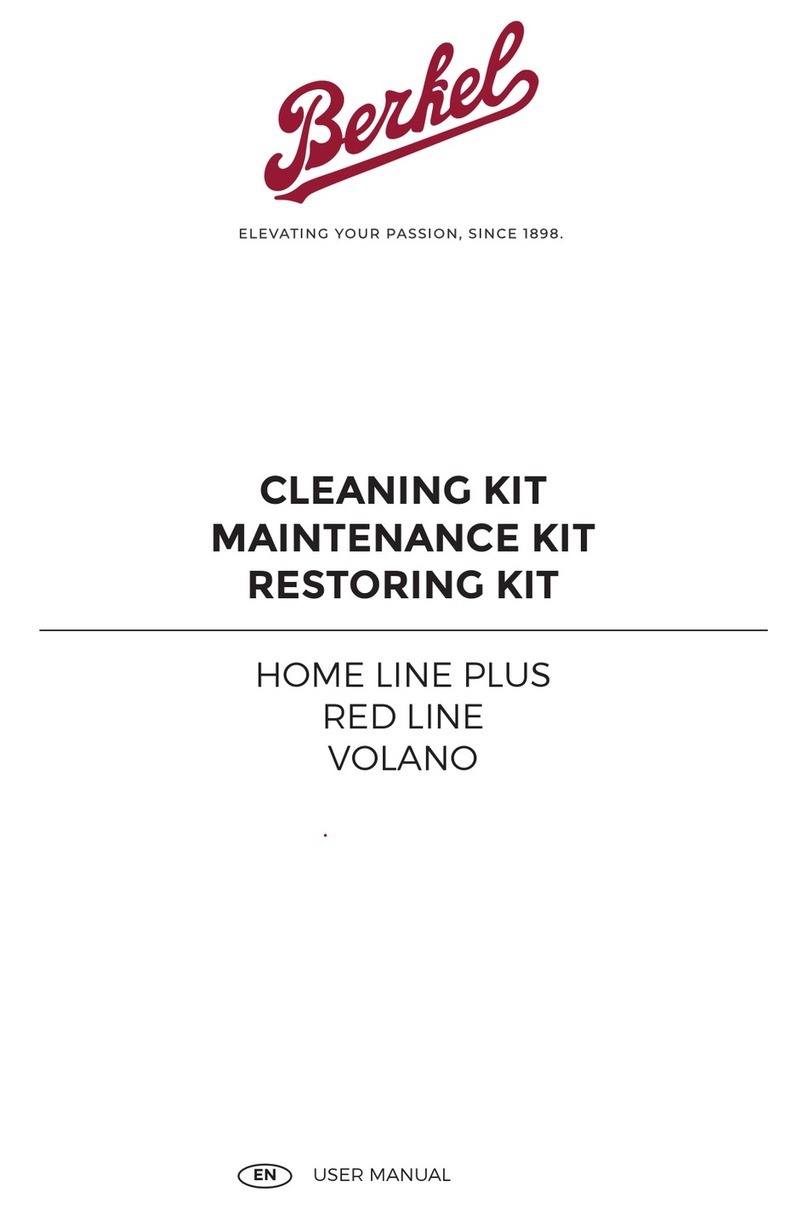
Berkel
Berkel HOME LINE PLUS Series User manual
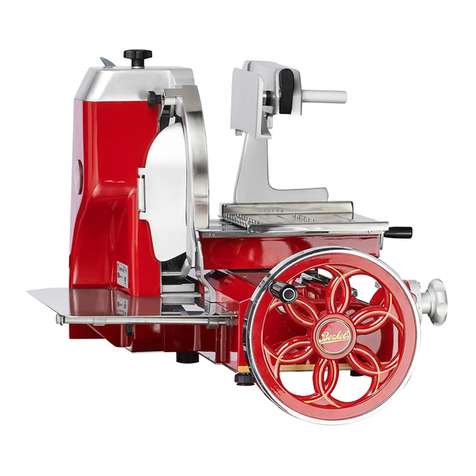
Berkel
Berkel 330M User manual

Berkel
Berkel 932 User manual
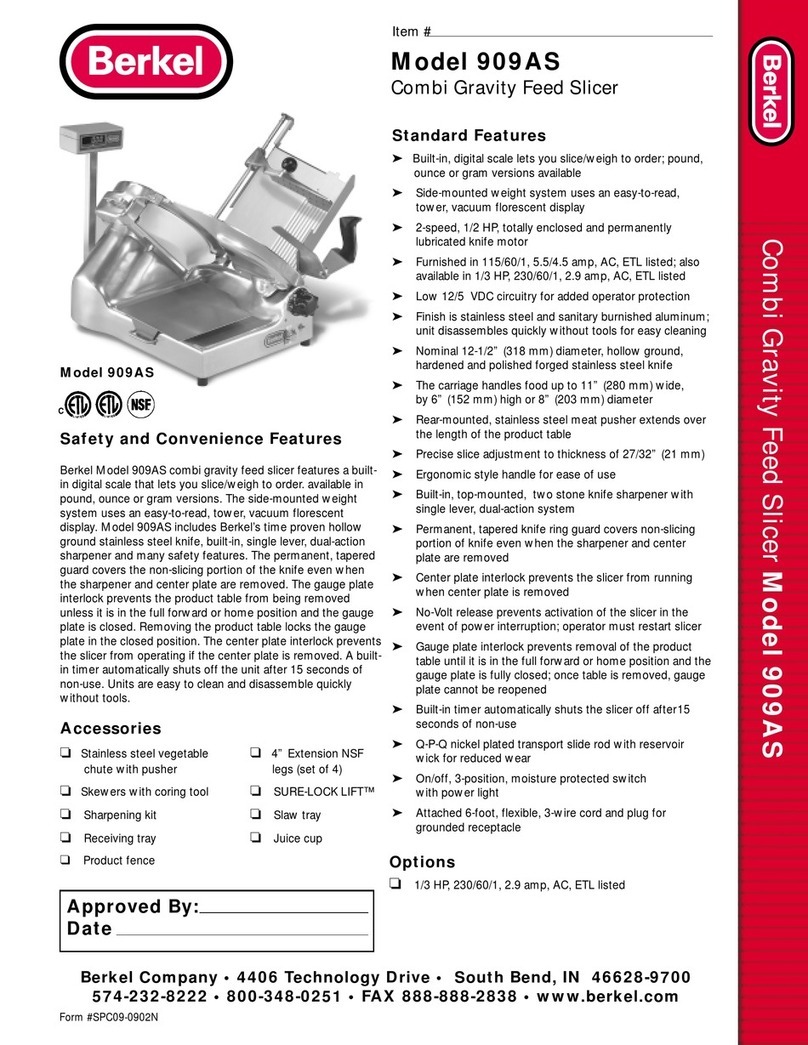
Berkel
Berkel 909AS User manual
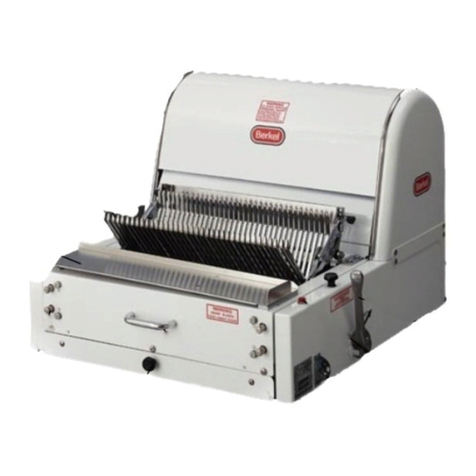
Berkel
Berkel MB User manual
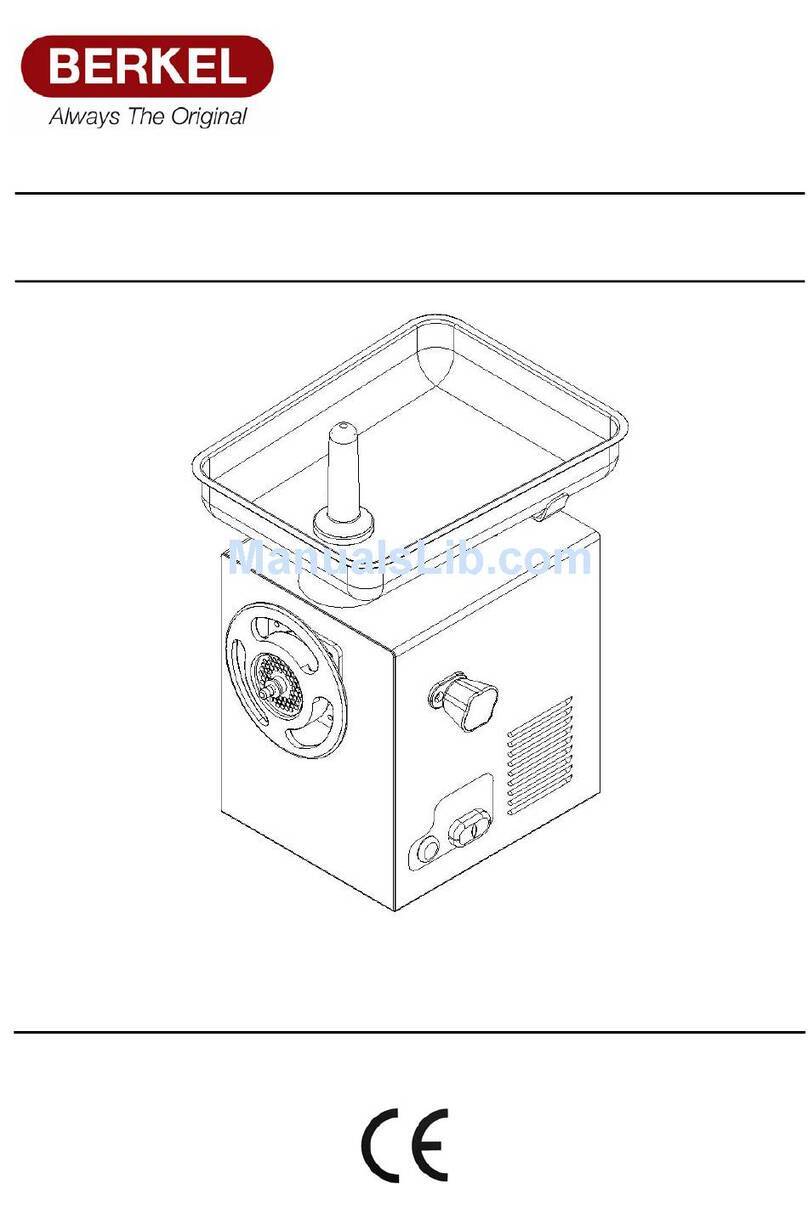
Berkel
Berkel BMS 22 T User manual

Berkel
Berkel FUTURA Series User manual
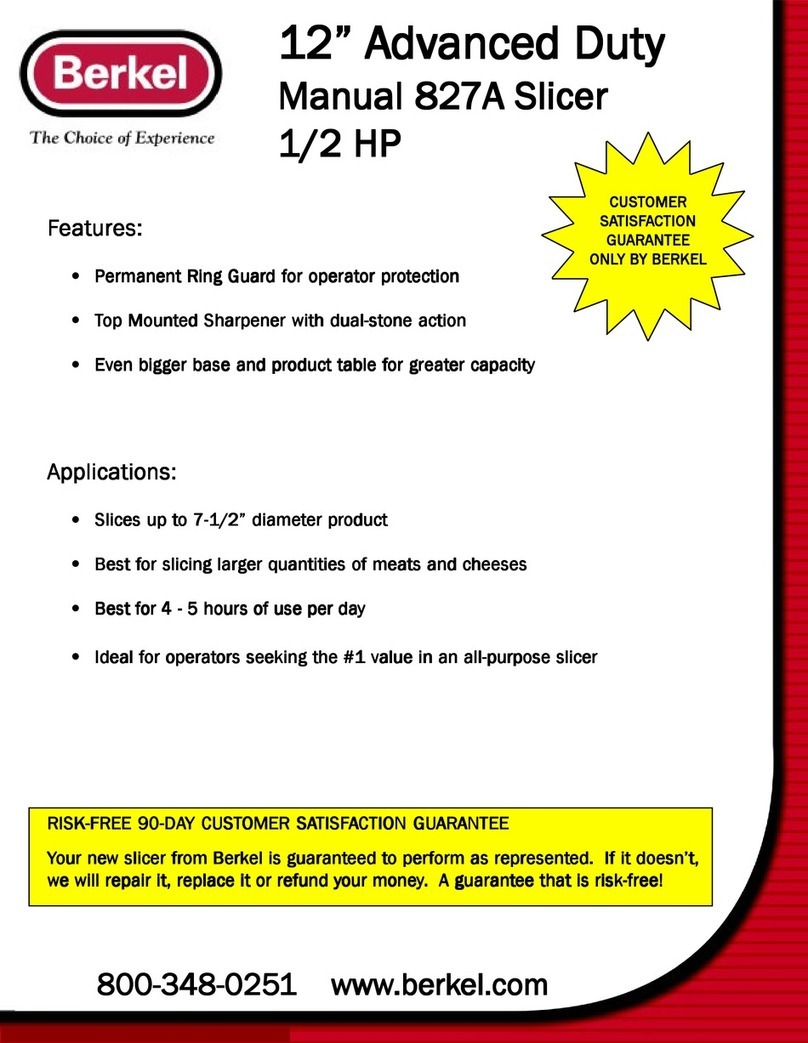
Berkel
Berkel 827A User manual

Berkel
Berkel 330M Troubleshooting guide
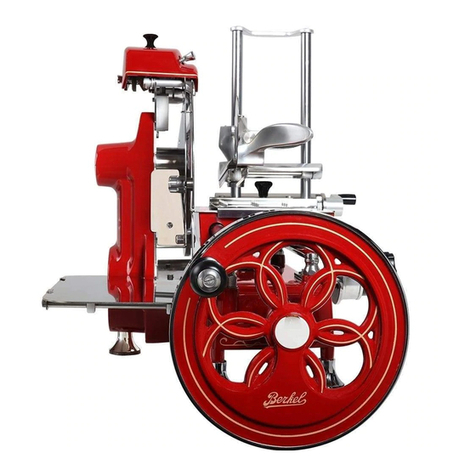
Berkel
Berkel VOLANO P15 User manual
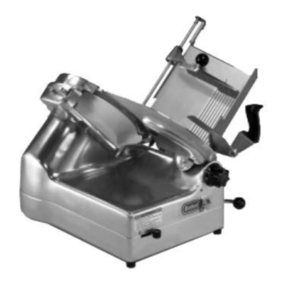
Berkel
Berkel 909/1 User manual

Berkel
Berkel 818 User manual
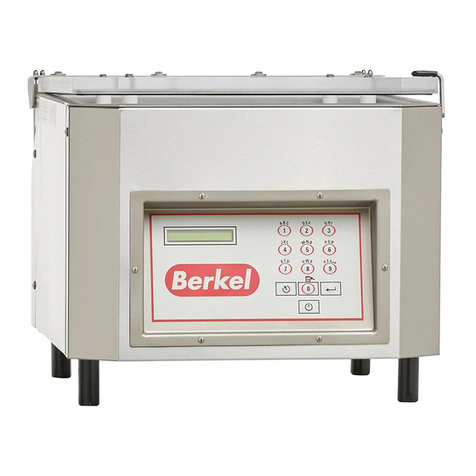
Berkel
Berkel 350 User manual

Berkel
Berkel BES300 User manual
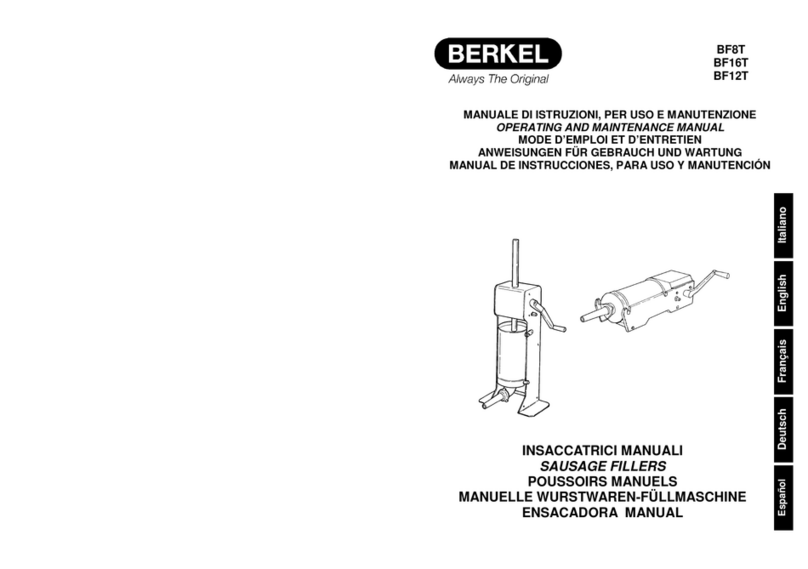
Berkel
Berkel BF8T Operating instructions
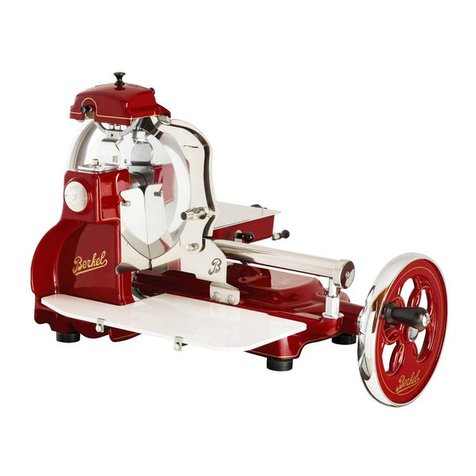
Berkel
Berkel VOLANO Series User manual

Berkel
Berkel 808 User manual
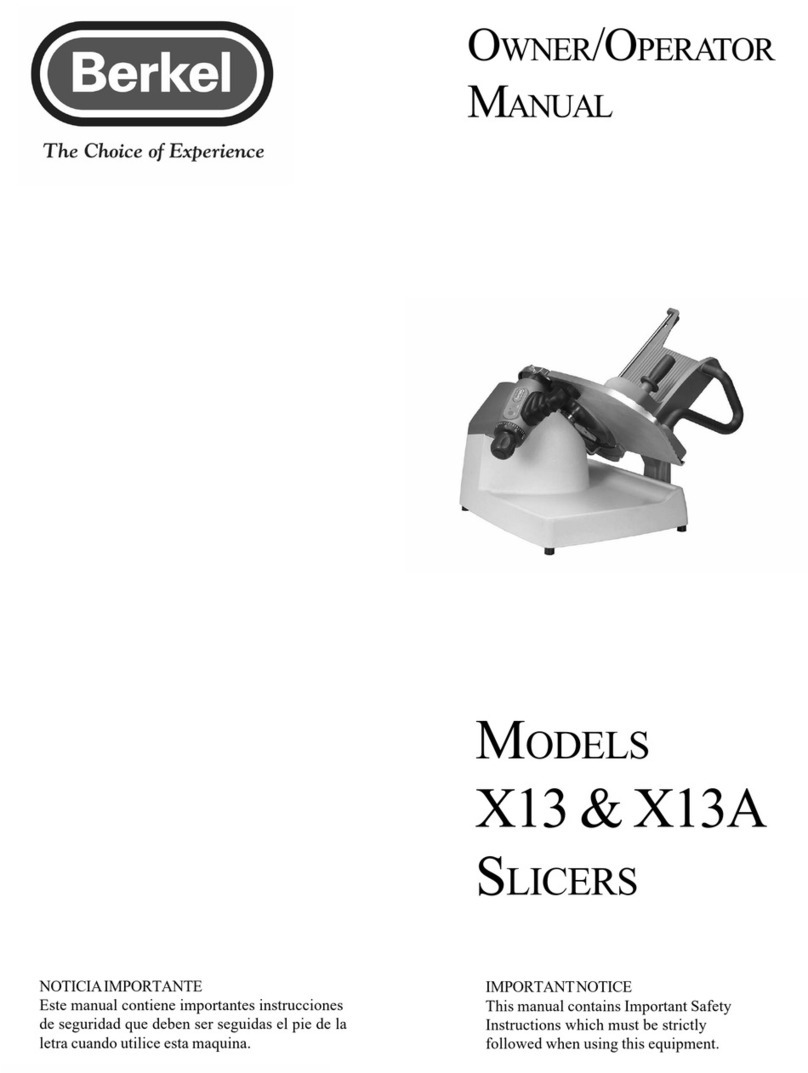
Berkel
Berkel X13 Owner's manual

Berkel
Berkel 330M Owner's manual
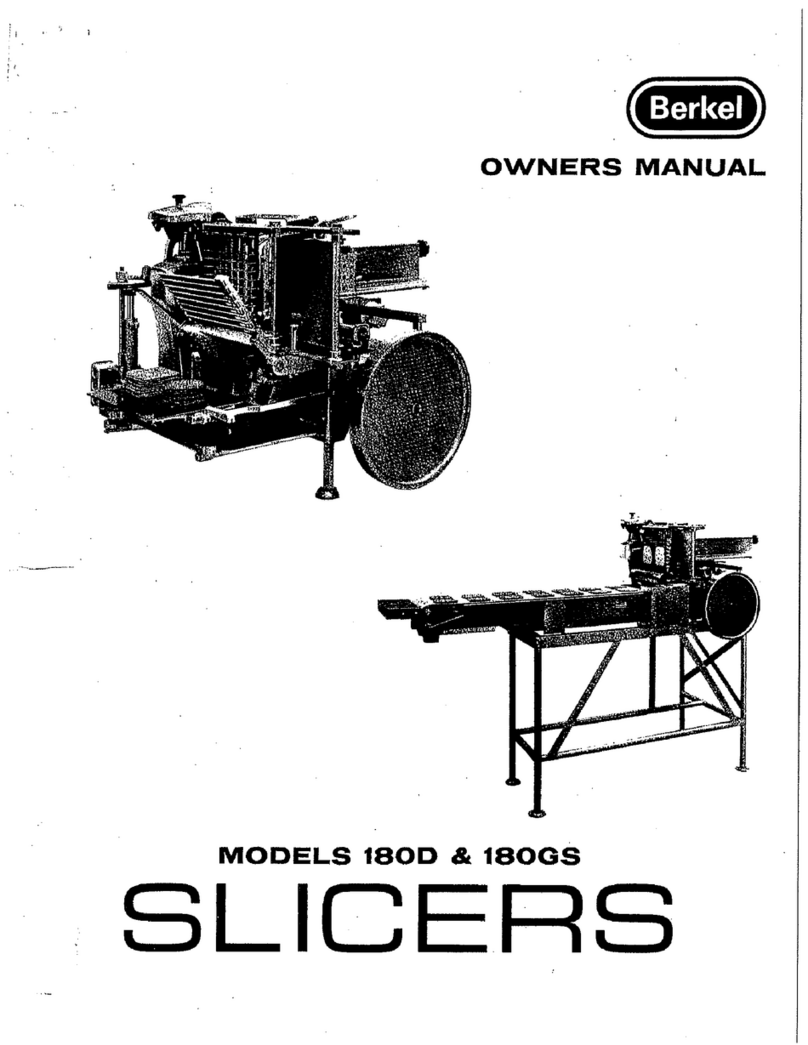
Berkel
Berkel 180D User manual
